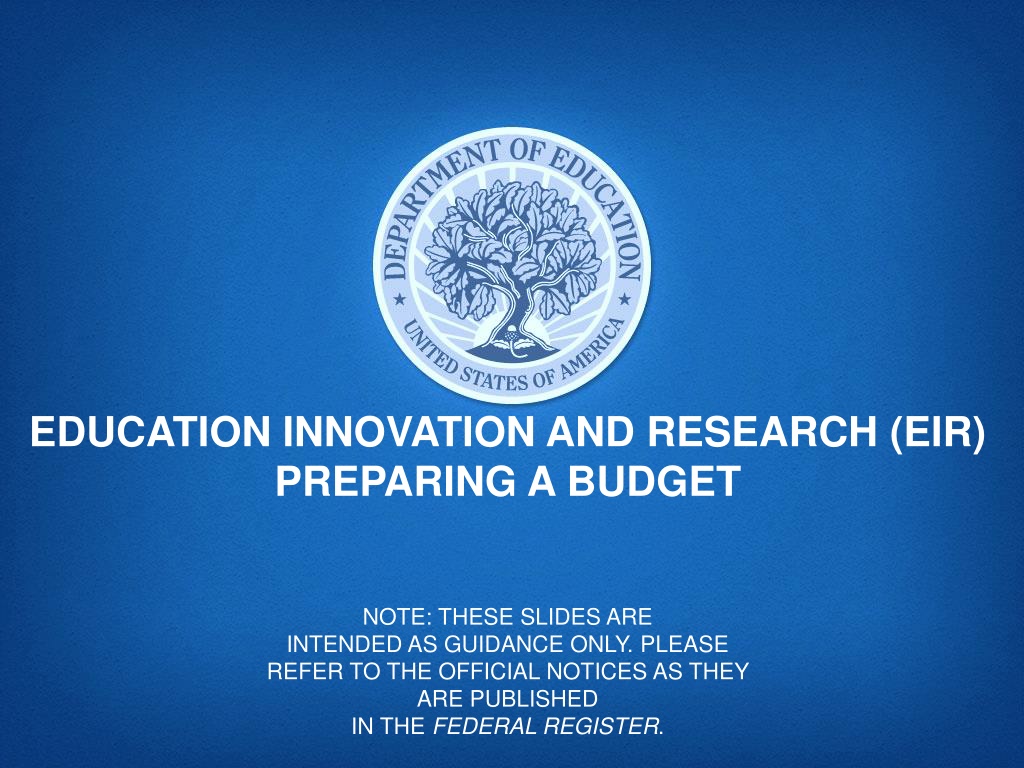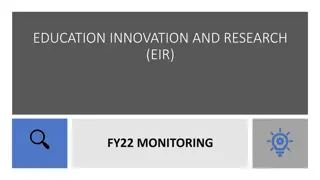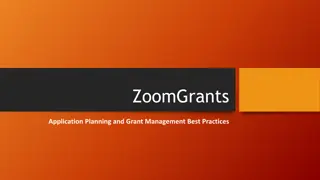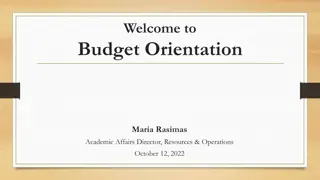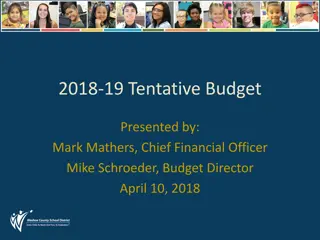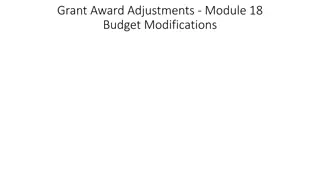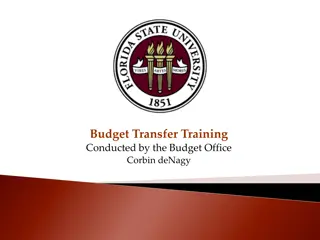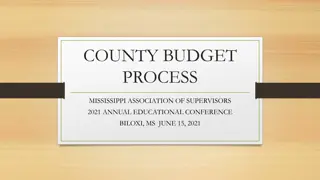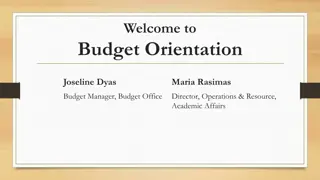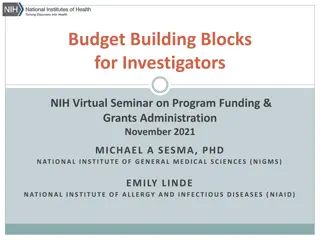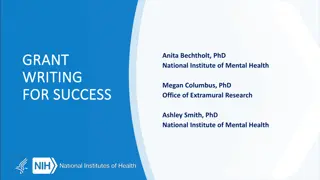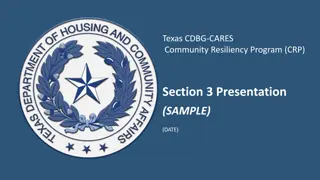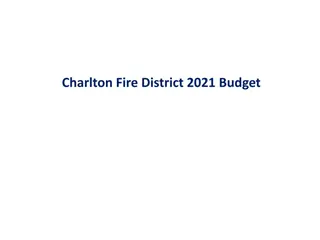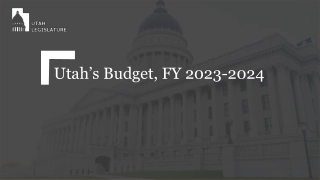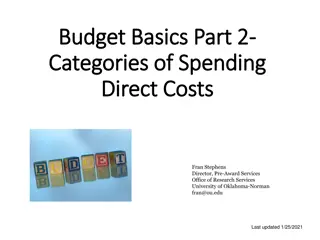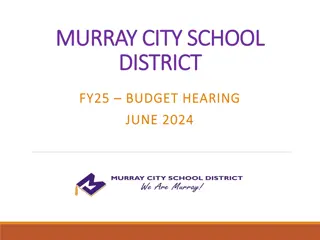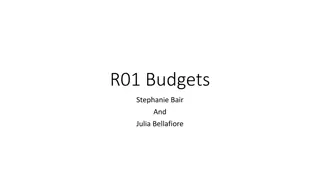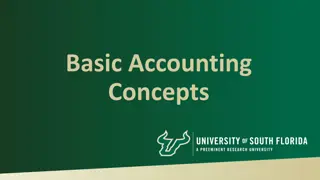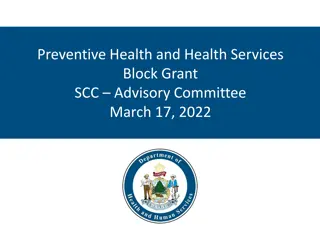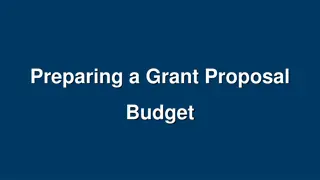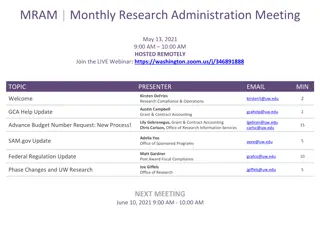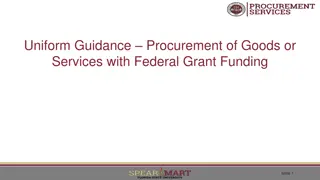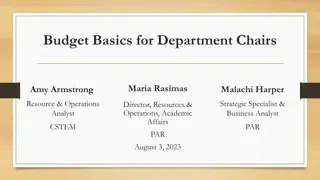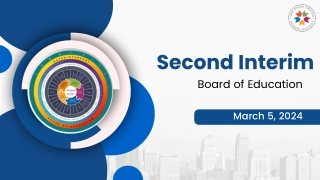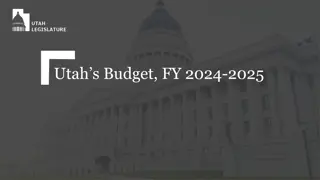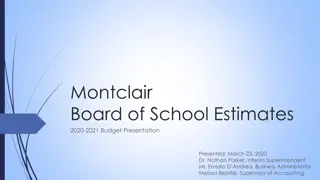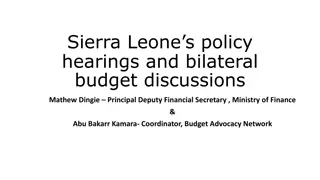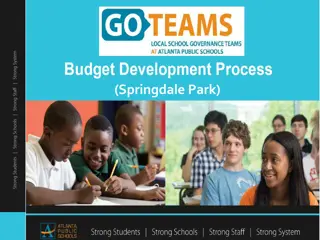Guidance for EIR Grant Budget Preparation and Cost Principles
These slides provide guidance on preparing a budget for Education Innovation and Research (EIR) grants. They include application instructions, details on cost principles, and prohibitions on subgrants for EIR projects. Grantees must adhere to 2 CFR Part 200 and the Uniform Administrative Requirements. Effective August 13, 2020, certain telecommunication and video surveillance services are prohibited under Section 889 of the 2019 National Defense Authorization Act. Subgrants are not allowed for EIR grants; instead, grantees can enter into contracts for project-related services following specified procurement procedures.
Download Presentation

Please find below an Image/Link to download the presentation.
The content on the website is provided AS IS for your information and personal use only. It may not be sold, licensed, or shared on other websites without obtaining consent from the author. Download presentation by click this link. If you encounter any issues during the download, it is possible that the publisher has removed the file from their server.
E N D
Presentation Transcript
EDUCATION INNOVATION AND RESEARCH (EIR) PREPARING A BUDGET NOTE: THESE SLIDES ARE INTENDED AS GUIDANCE ONLY. PLEASE REFER TO THE OFFICIAL NOTICES AS THEY ARE PUBLISHED IN THE FEDERAL REGISTER.
APPLICATION INSTRUCTIONS The application instructions includes details for completing the budget information (ED Form 524) and the budget narrative. 2
COST PRINCIPLES In expending and accounting for funds awarded under the EIR program, grantees must follow 2 CFR Part 200, the Uniform Administrative Requirements, Cost Principles, and Audit Requirements for Federal Awards (Uniform Guidance) eCFR :: 2 CFR Part 200 -- Uniform Administrative Requirements, Cost Principles, and Audit Requirements for Federal Awards as adopted by the Department of Education at 2 CFR 3474 eCFR :: 2 CFR Part 3474 -- Uniform Administrative Requirements, Cost Principles, and Audit Requirements for Federal Awards . Additional information on the Uniform Guidance can be found at this link Uniform Administrative Requirements, Cost Principles, and Audit Requirements for Federal Awards | U.S. Department of Education 3
COST PRINCIPLES Effective August 13, 2020, 2 CFR 200.216 for U.S. organizations and the mandatory standard provision Prohibition on Certain Telecommunication and Video Surveillance Services or Equipment for non-U.S. organizations implemented the statutory prohibition 889(b)(1) that prohibits the use of award funds, including direct and indirect costs, cost-share and program income, to procure covered telecommunication and video surveillance services or equipment. Section 889 of the 2019 National Defense Authorization Act prohibits the federal government, government contractors, and grant and loan recipients from procuring or using certain covered telecommunication equipment or services that are produced by Huawei, ZTE, Hytera, Hikvision, and Dahua and their subsidiaries as a substantial or essential component of any system, or as critical technology as part of any system. 4
PROHIBITION OF SUBGRANTS Subgrants are not authorized for EIR grants. Under Department of Education regulations, 34 CFR 77.1, the terms subgrant and subaward have the same meaning. Consequently, subawards, as that term is defined the Uniform Guidance, 2 CFR 200.1, are prohibited. Grantees can enter into contracts with parties they wish to work in their EIR project, such as their independent evaluator. When you need to pay another party for goods and services needed to carry out the grant project, you must follow the applicable procurement procedures set out in 2 CFR 200.317- 326. 34 CFR 75.135 provides flexibility on procurement requirement as it relates to on selecting contractors that might be relevant to developing project proposals. 5
PREPARING YOUR BUDGET NARRATIVE PERSONNEL AND FRINGE Personnel: Base salary of each personnel member. Wages to be earned on the grant work. The percentage of time devoted to the project (% FTE). Fringe Benefits: To which personnel the fringe benefits are being charged. The rate of fringe. 6
EIR BUDGET NARRATIVE EXAMPLE PERSONNEL AND FRINGE Year 1 Year 2 Year 3 Year 4 Year 5 Personnel Base Base Base Base Base Wages FTE Wages FTE Wages FTE Wages FTE Wages FTE Salary Salary Salary Salary Salary Project $62,400 $46,800 75% $64,272 $48,204 75% $66,200 $49,650 75% $68,186 $51,140 75% $70,232 $52,674 75% Director Project $49,400 $24,700 50% $50,882 $25,441 50% $52,409 $26,205 50% $53,981 $26,991 50% $55,600 $13,900 25% Coordinator Research $44,200 $11,050 25% $45,526 $22,763 50% $46,892 $23,446 50% $48,299 $12,075 25% $49,748 $24,874 50% Assistant Administrative $44,200 $8,840 20% $45,526 $9,105 20% $46,892 $9,378 20% $48,299 $9,660 20% $49,748 $9,950 20% Assistant Total Costs $91,390 $105,513 $108,679 $99,866 $101,398 Personnel: For each employee, salary costs were determined based upon the number of workdays they will dedicate to the project each year. It is assumed that salaries will increase at a rate of 3% per year. Fringe Benefits: Fringe benefits are calculated at a rate of 45% of the projected personnel wages for all of the personnel listed in the chart above. These pay for health-care, dental, long-term disability, and life insurance; pre-tax medical and dependent care benefits; a retirement plan; Social Security and Medicare taxes; worker's compensation and unemployment; personal and sick leave; and 14 holidays. 7
PREPARING YOUR BUDGET NARRATIVE TRAVEL Travel: Where are personnel traveling too? The number of people that will be traveling. A breakdown of the costs associated with each trip and justification for the costs. Applicants should include costs for four project staff persons (project director, evaluator, and two partners) to attend an annual, 2-day project directors meeting in Washington, DC as well as one, 2-day post-award meeting in Washington, DC. 8
EIR BUDGET NARRATIVE EXAMPLE TRAVEL Year 1 Year 2 Year 3 Year 4 Year 5 Types of Travel Unit Cost # Trips Costs # Trips Costs # Trips Costs # Trips Costs # Trips Costs Partner Meetings and Classroom $54.50 16 $872 80 $4,360 80 $4,360 80 $4,360 16 $872 Observations(LEA) Coaching Travel $54.50 0 $ - 80 $4,360 480 $26,160 400 $21,800 0 $ - Project Directors Meeting $1,420.00 4 $5,680 4 $5,680 4 $5,680 4 $5,680 4 $5,680 Dissemination $1,690.00 0 $ - 3 $5,070 3 $5,070 3 $5,070 6 $10,140 Total Costs $6,552 $19,470 $41,270 $36,910 $16,692 Four types of travel by Applicant X staff are included as federal costs for this line item. First is travel to meet with our Local Educational Agency (LEA) partner, ABC Public Schools (ABC). This includes Applicant X staff s travel to visit and observe ABC classrooms. Second is trainers travel to preschool and kindergarten classrooms for individual coaching sessions. These first two types of travel are budgeted at $54.50 ($.545 per mile at 100 miles) per trip. The third and fourth types of travel are long-distance traveling. They include yearly travel for four project personnel to attend the two-day EIR grantee meeting in Washington, DC and dissemination travel to attend research conferences to present ongoing work and findings from the project. For dissemination, three project staff are budgeted to attend one conference in Years 2, 3, and 4. In Year 5, three staff are budgeted to attend two conferences. All long-distance travel is budgeted at $250/night for hotel; airfare $600; parking $22/day; per diem $40/day; $54.5 for mileage to and from airport at $.545/mile; and $100 for taxi. Project director s meeting travel is budgeted for 2 days and dissemination travel is budgeted for 3 days. 9
PREPARING YOUR BUDGET NARRATIVE EQUIPMENT Equipment: Equipment means tangible nonexpendable personal property including exempt property charged directly to the award having a useful life of more than one year and an acquisition cost threshold of $5,000 or more per unit, unless your organization sets that cost threshold at a lower level. The amount of equipment that is being purchased. Cost per unit. Justification of purchases that links to the project narrative. 10
PREPARING YOUR BUDGET NARRATIVE SUPPLIES Supplies: Supplies are defined as all tangible personal property other than equipment as defined in the previous slide. Supplies purchased with grant funds, as budgeted in the grant agreement, belong to the grantee. Supplies are to be used for the originally authorized purposes as long as needed for that purpose. The amount of supplies that are being purchased. Cost per unit. Justification of purchases that links to the project narrative. 11
PREPARING YOUR BUDGET NARRATIVE Contractual: Identify with whom the contract is. Amount of the contract (This amount should include a breakdown of the major service components of the contract and how much each portion costs). Explanation/justification of what services are being provided by the contractor. Under the Contractual line item, EACH contract needs to be broken down into the detail described above. The next slide will provide an example of the detail needed for a breakdown of ONE individual contract. 12
EIR BUDGET NARRATIVE EXAMPLE CONTRACTUAL Major Service Component Personnel Costs Travel Costs Printing/PostageCosts Year 1 Year 2 Year 3 Year 4 Year 5 Total $149,220 $5,000 $10,000 $149,220 $5,000 $10,000 $149,220 $5,000 $10,000 $149,220 $5,000 $10,000 $149,220 $5,000 $10,000 $746,100 $25,000 $50,000 IRB ApprovalCosts Total $5,780 $170,000 $5,780 $170,000 $5,780 $170,000 $5,780 $170,000 $5,780 $170,000 $28,900 $850,000 Assessment University Contract Breakdown Assessment University (AU) will serve as the external, independent evaluator for the project. Dr. John Doe will serve as the lead evaluator/principal investigator and will oversee the evaluation design and execution. Specifically, AU will take the lead on finalizing the research design and obtaining USED-approval for the design; write and submit the evaluation progress reports; obtain all necessary IRB approvals or exemptions; work to develop and finalize the outcome questionnaire to measure short-term attitudinal and behavior outcomes. AU will also work in collaboration with Applicant X to develop parental consent forms for study participation; conduct random assignment of the student participants to randomly assign eligible participants to the treatment or control experimental condition; administer the outcome questionnaire at each of the study sites to students in the treatment and control groups at baseline (prior to program implementation) and immediately following program participation. Other tasks include follow-up with students who were absent on the survey administration day or who are no longer enrolled in school to ensure they complete a survey; collecting school record data for study participants from each district/school; entering school records, survey data, and fidelity data, and performing general data management and ensure data integrity; conducting impact analyses to measure impacts of Program X on student outcomes; conducting implementation analyses to provide context to the impact findings; and working in collaboration with Applicant X to develop articles to submit study results for publication in peer-reviewed journals and to develop proposals for presenting results at national conferences. AU s total breakdown of costs are as follows: Personnel costs ($746,100) include 9,150 staff hours. Personnel costs include Dr. John Doe, Lead Evaluator (450 hours x $190/hour); Dr. Jane Roe, Senior Research Analyst (2,700 hours x $102/hour); Joe Schmoe, Junior Research Analyst (4,200 hours x $69/hour); two Research Assistants (To be hired)(1,800 hours x $53/hour). Travel costs include staff to school sites (20 total trips at $1250/trip = $25,000) to meet with program staff, conduct training, and obtain parental consent for student participation in study. Printing and postage costs ($50,000) include printing locator forms, mailing instruments to Applicant X and to the schools, and scanning of questionnaires. Other costs include IRB approval costs for multiple sites across multiple years ($28,900). Total AU Costs = $850,000. 13
PREPARING YOUR BUDGET NARRATIVE CONSTRUCTION AND OTHER Construction: There should be no construction costs in the budget. Other: Explanation of why the stated expense is separated into this particular budget line item. (Make sure the provided reasoning is logical and that the expense listed in this section does not actually belong in one of the other line items of the ED 524 Budget Form.) Please review the Department s guidance on Federal funds for meals. 14
PREPARING YOUR BUDGET NARRATIVE INDIRECT COSTS Indirect costs are those that have been incurred for common or joint objectives and cannot be readily identified with a particular final cost objective. What is the indirect cost rate? What is the basic calculation of this rate, and is it applied correctly? To be applied correctly, the indirect cost rate is applied to the modified total direct cost, 2 CFR 200.1(MTDC). If an applicant has an approved indirect cost rate, please include in the Other Attachments section of your application a copy of the applicant s approved indirect cost rate agreement. For additional information, refer to The Department's Indirect Cost Group Website, Indirect Cost Training Course, and Indirect Cost Decision Tree 15
PREPARING YOUR BUDGET NARRATIVE TRAINING STIPENDS Training Stipends: Amount of stipend. Number of grant participants receiving stipends. Justification for stipend. Are all stipend amounts listed in the Training Stipends line item? (It is common for applicants to mistakenly place stipend funds in the Personnel or Other line items. This is important to correct because training stipends are not calculated in the modified total direct cost (MTDC) and should be separated out.) 16
PREPARING YOUR BUDGET NARRATIVE NON-FEDERAL FUNDS (MATCHING FUNDS) Non-Federal Funds (Matching Funds): The non- federal budget requires the same level of detail that was described in the preceding slides about the federal budget. 17
THANK YOU! EIR EMAIL: EIR@ED.GOV EIR PHONE: (202) 453-7122
